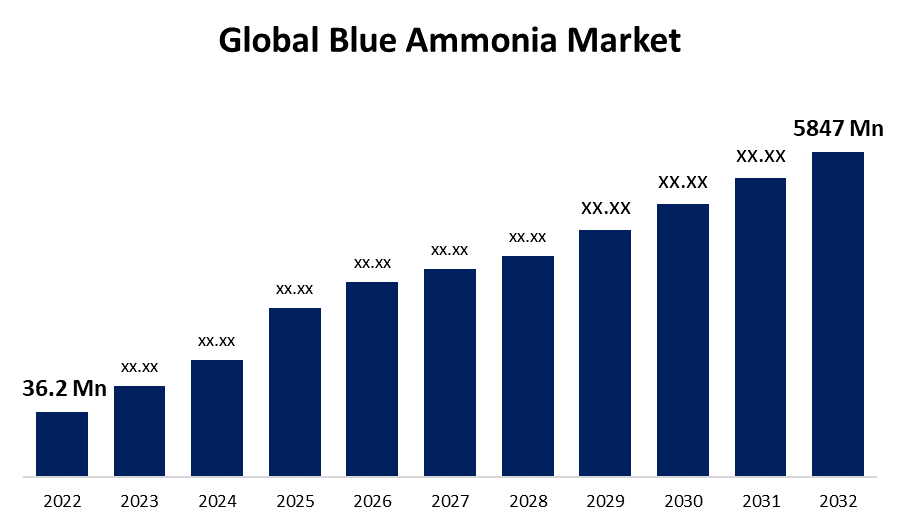Global Blue Ammonia Market Size, Share, and COVID-19 Impact Analysis, By Technology (Steam Methane Reforming, Autothermal Reforming, Gas Partial Oxidation), By Application (Power Generation, Industrial Feedstock, Agriculture, Pharmaceuticals, Transportation, Chemical & Petrochemicals, Others), and By Region (North America, Europe, Asia-Pacific, Latin America, Middle East, and Africa), Analysis and Forecast 2022 – 2032
Industry: Chemicals & MaterialsGlobal Blue Ammonia Market Insights Forecasts to 2032
- The Global Blue Ammonia Market Size was valued at USD 36.2 Million in 2022.
- The Market is Growing at a CAGR of 66.2% from 2022 to 2032
- The Worldwide Blue Ammonia Market Size is expected to reach USD 5,847 Million by 2032
- Asia Pacific is expected to Grow the fastest during the forecast period

Get more details on this report -
The Global Blue Ammonia Market Size is expected to reach USD 5,847 Million by 2032, at a CAGR of 66.2% during the forecast period 2022 to 2032.
Blue ammonia is produced through steam methane reformation, a low-carbon process. Blue ammonia is created by combining nitrogen and "blue" hydrogen from natural gas feedstocks, with the carbon dioxide by-product from hydrogen production recovered and stored. Ammonia can be utilized as a low-carbon fuel in a variety of industrial applications, including transportation, power generation, and steel, cement, and fertilizer manufacturing. With a growing demand for hydrogen as a fuel, ammonia has emerged as a convenient option to store it. Hydrogen, a clean-burning fuel with no carbon emissions, can be produced by turning ammonia into a gas for use in applications such as automobile fuel cells. In addition, using low-cost natural gas, blue ammonia can cheaply decarbonize the fertilizer business, with additional possibilities to decarbonize combustion fuels. When paired with carbon capture, blue low-carbon ammonia is comparable to conventional grey ammonia and can reduce carbon emissions by more than 90%. Blue ammonia is being used by industries and nations devoted to net-zero energy because it shows high potential as a long-term energy carrier and as a means for decreasing greenhouse gas emissions as an environmentally friendly or carbon-neutral fuel.
The major key players in the global blue ammonia market include OCI, Ma’aden, CF Industries Holdings, Inc., Yara International ASA, Saudi Arabian Oil Co., ITOCHU Corporation, Técnicas Reunidas S. A., PAO NOVATEK, ADNOC Group, and Hydrofuel Canada Inc. In order to maintain their competitive edge and achieve revenue growth, these companies are focusing on R&D, product innovation, and strategic collaborations. For instance, On June 2023, BASF and Yara Clean Ammonia are working together on a collaborative study to develop and build a world-scale low-carbon blue ammonia production facility with carbon capture in the Gulf Coast region of the United States. To meet the expanding worldwide demand for low-carbon ammonia, the firms are investigating the viability of a facility with a total capacity of 1.2 to 1.4 million tons per year.
Global Blue Ammonia Market Report Coverage
| Report Coverage | Details |
|---|---|
| Base Year: | 2022 |
| Market Size in 2022: | USD 36.2 Million |
| Forecast Period: | 2022-2032 |
| Forecast Period CAGR 2022-2032 : | 66.2% |
| 2032 Value Projection: | USD 5,847 Million |
| Historical Data for: | 2018-2021 |
| No. of Pages: | 210 |
| Tables, Charts & Figures: | 110 |
| Segments covered: | By Technology, By Application, By Region and COVID-19 Impact Analysis |
| Companies covered:: | Shell, OCI, Ma’aden, Linde plc, Uniper SE, LSB Industries, CF Industries Holdings, Inc., Yara International ASA, Saudi Arabian Oil Co., ITOCHU Corporation, Técnicas Reunidas S. A., PAO NOVATEK, ADNOC Group, Hydrofuel Canada Inc., QATAR FERTILISER COMPANY, ExxonMobil Corporation, Dastur Energy, and Other Market Players |
| Pitfalls & Challenges: | COVID-19 Empact,Challenges, Future, Growth, & Analysis |
Get more details on this report -
Driving Factors
The blue ammonia market is an expanding industry within the globally operating energy and chemical industries, particularly an emphasis on the generation and use of ammonia (NH3) obtained from natural gas, alongside carbon capture and storage (CCS) technology to reduce carbon dioxide (CO2) emissions. The newly developed approach to ammonia manufacturing is gaining traction due to its potential to cut greenhouse gas emissions and play an important role in the switch to a more sustainable energy future. One of the key advantages of blue ammonia is its ability to transport hydrogen. Given the increasing worldwide emphasis on hydrogen as a clean fuel option, efficient delivery and storage are critical. Blue ammonia's potential applications are not limited to being a hydrogen conduit; it also has potential as a direct fuel for power generation and as a chemical feedstock in a variety of industries. As a result of the increased interest in sustainable energy solutions, the blue ammonia market is positioned for growth. Furthermore, blue ammonia has the potential to be utilized as a clean fuel in power generation, particularly in locations where natural gas has historically been used. It can also be used as a feedstock in a variety of industries, including agriculture and chemicals.
Market Segmentation
By Technology Insights
The steam methane reforming segment is dominating the market with the largest revenue share over the forecast period.
On the basis of technology, the global blue ammonia market is segmented into the steam methane reforming, autothermal reforming, and gas partial oxidation. Among these, the steam methane reforming segment is dominating the market with the largest revenue share of 57.3% over the forecast period, due to its affordable and environmentally friendly technique of producing pure hydrogen. Under high pressures and temperatures, a catalyst is used to facilitate the direct reaction of steam and methane during the process. As a result of this process, synthesis gas (syngas) is produced, which is then combined with nitrogen to produce ammonia. Steam methane reforming is a highly productive method that allows excellent use of the heat and chemical energy of the reactants.
By Application Insights
The agriculture segment accounted for the largest revenue share of more than 32.8% over the forecast period.
On the basis of application, the global blue ammonia market is segmented into power generation, industrial feedstock, agriculture, pharmaceuticals, transportation, chemical & petrochemicals, and others. Among these, the agriculture segment is dominating the market with the largest revenue share of 32.8% over the forecast period. Farmers try to address various demand and consumption challenges by balancing rising agricultural outputs with minimizing their ecological impact. This is causing a strong demand for blue ammonia from various producers, which has contributed to revenue growth in this market. Blue ammonia is important in this condition because it gathers nitrogen from the air and makes it available for the production of nitrogen fertilizers. When compared to other fertilizer products, blue ammonia fertilizer has one of the lowest carbon footprints per kilogram of product and nitrogen delivered to the soil. This makes it an environmentally friendly choice for farmers searching for long-term fertilization solutions. Furthermore, policymakers and food industries around the world are supporting the need for environmentally friendly fertilizers, which are expected to be progressively implemented to reduce emissions from agriculture.
Regional Insights
North America dominates the market with the largest market share over the forecast period.

Get more details on this report -
North America is dominating the market with more than 38.7% market share over the forecast period. This is due to increased activity by key market participants in this region to establish various infrastructures for the development of blue ammonia products. With its cleaner production process, blue ammonia is seen as a promising solution to the climate crisis. It has a wide range of applications, including fuel cells, maritime operations, and fertilizer manufacturing. Considering the growing demand for blue ammonia, there is an increased likelihood that more projects will be established in North America and especially in United States.
Asia Pacific, on the contrary, is expected to grow the fastest during the forecast period. This is owing to the region's fast growth and development, as well as favorable government regulations encouraging the use of renewable energy sources. As a result of this expansion, there is a greater desire for greener energy sources to reduce carbon emissions, making blue ammonia a favored alternative for many sectors. Furthermore, the expansion of infrastructure, particularly in the transportation and storage of ammonia, is fueling the growth of the Asia Pacific blue ammonia market.
The Europe market is expected to register a substantial CAGR growth rate during the forecast period. European countries have made an effort to reduce their carbon footprints and have been among the early adopters of various green energy technologies. Given its potential as a green fuel, blue ammonia aligns strongly with Europe's transition to renewable energy ambitions. As a result, there is a greater interest in technologies and fuels that can assist in attaining the carbon-neutral aim, with blue ammonia playing an important role in the market.
List of Key Market Players
- Shell
- OCI
- Ma’aden
- Linde plc
- Uniper SE
- LSB Industries
- CF Industries Holdings, Inc.
- Yara International ASA
- Saudi Arabian Oil Co.
- ITOCHU Corporation
- Técnicas Reunidas S. A.
- PAO NOVATEK
- ADNOC Group
- Hydrofuel Canada Inc.
- QATAR FERTILISER COMPANY
- ExxonMobil Corporation
- Dastur Energy
Key Market Developments
- On March 2023, Mitsui & Co., Ltd., a major worldwide ammonia marketer, and CF Industries Holdings, Inc., the world's largest ammonia producer, announced a joint intention to build a greenfield ammonia production facility in the United States. Rather than using typical ammonia production methods, the newly constructed facility will manufacture blue ammonia using carbon capture and sequestration processes, cutting carbon emissions by more than 60%.
- On March 2023, Linde plc, a global industrial gases and engineering firm, and OCI, a global producer and distributor of hydrogen-based products, have inked a long-term deal in which Linde will supply clean hydrogen and nitrogen to OCI's new blue ammonia factory in Texas, US.
Market Segment
This study forecasts revenue at global, regional, and country levels from 2020 to 2032. Spherical Insights has segmented the Global Blue Ammonia Market based on the below-mentioned segments:
Blue Ammonia Market, Technology Analysis
- Steam Methane Reforming
- Autothermal Reforming
- Gas Partial Oxidation
- others
Blue Ammonia Market, Application Analysis
- Power Generation
- Industrial Feedstock
- Agriculture
- Pharmaceuticals
- Transportation
- Chemical & Petrochemicals
- Others
Blue Ammonia Market, Regional Analysis
- North America
- US
- Canada
- Mexico
- Europe
- Germany
- Uk
- France
- Italy
- Spain
- Russia
- Rest of Europe
- Asia Pacific
- China
- Japan
- India
- South Korea
- Australia
- Rest of Asia Pacific
- South America
- Brazil
- Argentina
- Rest of South America
- Middle East & Africa
- UAE
- Saudi Arabia
- Qatar
- South Africa
- Rest of Middle East & Africa
Need help to buy this report?